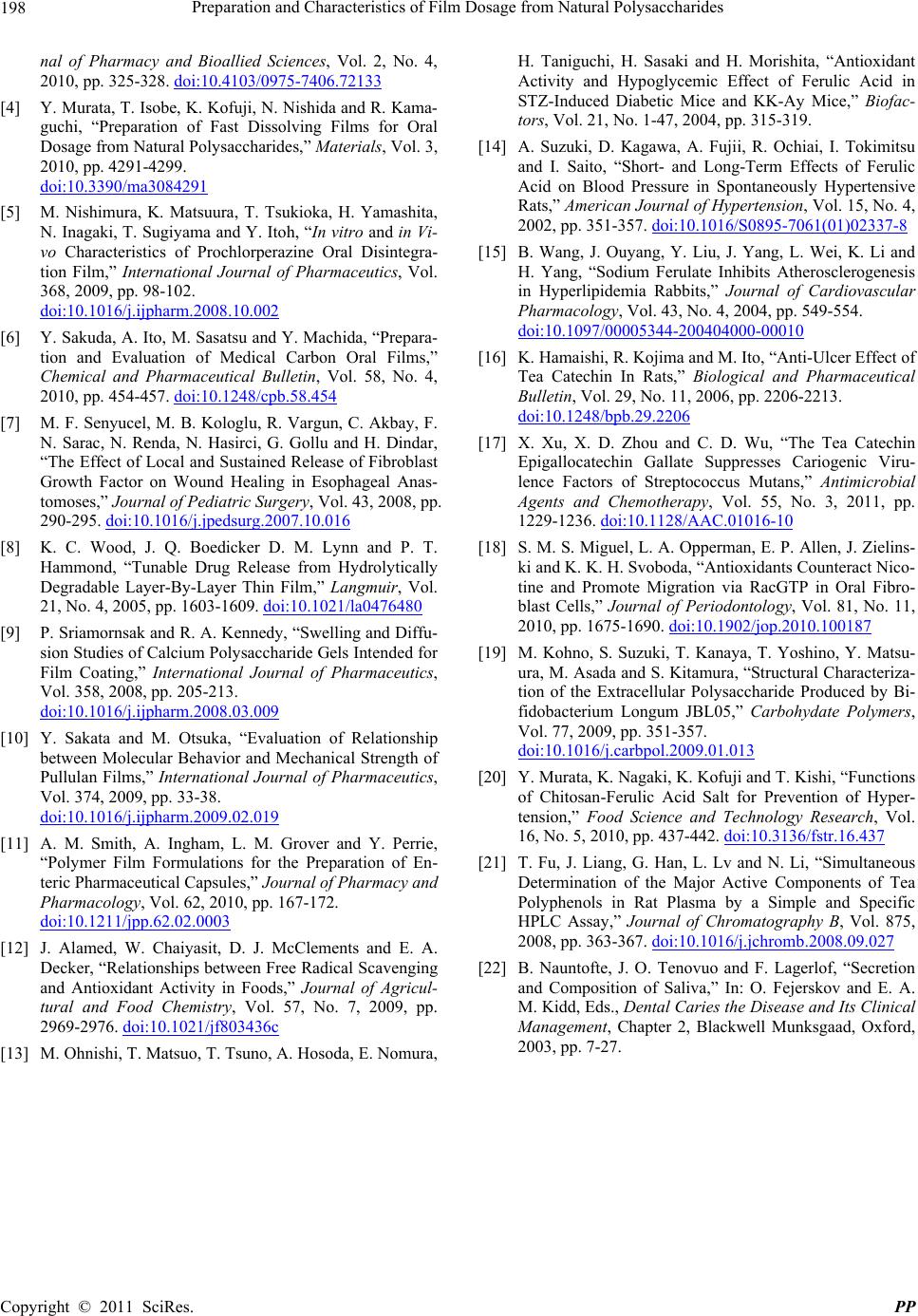
Preparation and Characteristics of Film Dosage from Natural Polysaccharides
Copyright © 2011 SciRes. PP
198
nal of Pharmacy and Bioallied Sciences, Vol. 2, No. 4,
2010, pp. 325-328. doi:10.4103/0975-7406.72133
[4] Y. Murata, T. Isobe, K. Kofuji, N. Nishida and R. Kama-
guchi, “Preparation of Fast Dissolving Films for Oral
Dosage from Natural Polysaccharide s,” Materials, Vol. 3,
2010, pp. 4291-4299.
doi:10.3390/ma3084291
[5] M. Nishimura, K. Matsuura, T. Tsukioka, H. Yamashita,
N. Inagaki, T. Sugiyama and Y. Itoh, “In vitro and in Vi-
vo Characteristics of Prochlorperazine Oral Disintegra-
tion Film,” International Journal of Pharmaceutics, Vol.
368, 2009, pp. 98-102.
doi:10.1016/j.ijpharm.2008.10.002
[6] Y. Sakuda, A. Ito, M. Sasatsu and Y. Machida, “Prepara-
tion and Evaluation of Medical Carbon Oral Films,”
Chemical and Pharmaceutical Bulletin, Vol. 58, No. 4,
2010, pp. 454-457. doi:10.1248/cpb.58.454
[7] M. F. Senyucel, M. B. Kologlu, R. Vargun, C. Akbay, F.
N. Sarac, N. Renda, N. Hasirci, G. Gollu and H. Dindar,
“The Effect of Local and Sustained Release of Fibroblast
Growth Factor on Wound Healing in Esophageal Anas-
tomoses,” Journal of Pediatric Surgery, Vol. 43, 2008, pp.
290-295. doi:10.1016/j.jpedsurg.2007.10.016
[8] K. C. Wood, J. Q. Boedicker D. M. Lynn and P. T.
Hammond, “Tunable Drug Release from Hydrolytically
Degradable Layer-By-Layer Thin Film,” Langmuir, Vol.
21, No. 4, 2005, pp. 1603-1609. doi:10.1021/la0476480
[9] P. Sriamornsak and R. A. Kennedy, “Swelling and Diffu-
sion Studies of Calcium Polysaccharide Gels Intended for
Film Coating,” International Journal of Pharmaceutics,
Vol. 358, 2008, pp. 205-213.
doi:10.1016/j.ijpharm.2008.03.009
[10] Y. Sakata and M. Otsuka, “Evaluation of Relationship
between Molecular Behavior and Mechanical Strength of
Pullulan Films,” International Journal of Pharmaceutics,
Vol. 374, 2009, pp. 33-38.
doi:10.1016/j.ijpharm.2009.02.019
[11] A. M. Smith, A. Ingham, L. M. Grover and Y. Perrie,
“Polymer Film Formulations for the Preparation of En-
teric Pharmaceutical Capsules,” Journal of Pharmacy and
Pharmacology, Vol. 62, 2010, pp. 167-172.
doi:10.1211/jpp.62.02.0003
[12] J. Alamed, W. Chaiyasit, D. J. McClements and E. A.
Decker, “Relationships between Free Radical Scavenging
and Antioxidant Activity in Foods,” Journal of Agricul-
tural and Food Chemistry, Vol. 57, No. 7, 2009, pp.
2969-2976. doi:10.1021/jf803436c
[13] M. Ohnishi, T. Matsuo, T. Tsuno, A. Hosoda, E. Nomura,
H. Taniguchi, H. Sasaki and H. Morishita, “Antioxidant
Activity and Hypoglycemic Effect of Ferulic Acid in
STZ-Induced Diabetic Mice and KK-Ay Mice,” Biofac-
tors, Vol. 21, No. 1-47, 2004, pp. 315-319.
[14] A. Suzuki, D. Kagawa, A. Fujii, R. Ochiai, I. Tokimitsu
and I. Saito, “Short- and Long-Term Effects of Ferulic
Acid on Blood Pressure in Spontaneously Hypertensive
Rats,” American Journal of Hypertension, Vol. 15, No. 4,
2002, pp. 351-357. doi:10.1016/S0895-7061(01)02337-8
[15] B. Wang, J. Ouyang, Y. Liu, J. Yang, L. Wei, K. Li and
H. Yang, “Sodium Ferulate Inhibits Atherosclerogenesis
in Hyperlipidemia Rabbits,” Journal of Cardiovascular
Pharmacology, Vol. 43, No. 4, 2004, pp. 549-554.
doi:10.1097/00005344-200404000-00010
[16] K. Hamaishi, R. Kojima and M. Ito, “Anti-Ulcer Effect of
Tea Catechin In Rats,” Biological and Pharmaceutical
Bulletin, Vol. 29, No. 11, 2006, pp. 2206-2213.
doi:10.1248/bpb.29.2206
[17] X. Xu, X. D. Zhou and C. D. Wu, “The Tea Catechin
Epigallocatechin Gallate Suppresses Cariogenic Viru-
lence Factors of Streptococcus Mutans,” Antimicrobial
Agents and Chemotherapy, Vol. 55, No. 3, 2011, pp.
1229-1236. doi:10.1128/AAC.01016-10
[18] S. M. S. Miguel, L. A. Opperman, E. P. Allen, J. Zielins-
ki and K. K. H. Svoboda, “Antioxidants Counteract Nico-
tine and Promote Migration via RacGTP in Oral Fibro-
blast Cells,” Journal of Periodontology, Vol. 81, No. 11,
2010, pp. 1675-1690. doi:10.1902/jop.2010.100187
[19] M. Kohno, S. Suzuki, T. Kanaya, T. Yoshino, Y. Matsu-
ura, M. Asada and S. Kitamura, “Structural Characteriza-
tion of the Extracellular Polysaccharide Produced by Bi-
fidobacterium Longum JBL05,” Carbohydate Polymers,
Vol. 77, 2009, pp. 351-357.
doi:10.1016/j.carbpol.2009.01.013
[20] Y. Murata, K. Nagaki, K. Kofuji and T. Kishi, “Functions
of Chitosan-Ferulic Acid Salt for Prevention of Hyper-
tension,” Food Science and Technology Research, Vol.
16, No. 5, 2010, pp. 437-442. doi:10.3136/fstr.16.437
[21] T. Fu, J. Liang, G. Han, L. Lv and N. Li, “Simultaneous
Determination of the Major Active Components of Tea
Polyphenols in Rat Plasma by a Simple and Specific
HPLC Assay,” Journal of Chromatography B, Vol. 875,
2008, pp. 363-367. doi:10.1016/j.jchromb.2008.09.027
[22] B. Nauntofte, J. O. Tenovuo and F. Lagerlof, “Secretion
and Composition of Saliva,” In: O. Fejerskov and E. A.
M. Kidd, Eds., Dental Caries the Disease and Its Clinical
Management, Chapter 2, Blackwell Munksgaad, Oxford,
2003, pp. 7-27.